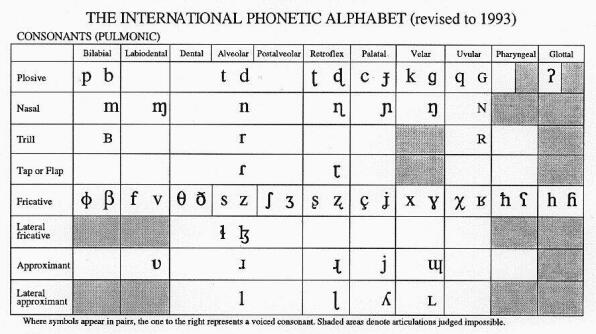Reading the IPA consonant chart
We've seen that we need to be able to answer
seven questions in
order to describe a consonant. We would need seven
dimensions in order to be able to perfectly chart the
properties of consonants. Unfortunately, real-world paper
only gives us two dimensions.
The layout of the IPA consonant chart solves this problem by
making the rows and columns stand for common combinations
or more than one question.
- Each column represents one of the most common places
of articulation, i.e., one of the common combinations of
answers to the questions about active articulator and passive
articulator.
- Each row represents one of the most common combinations
of answers to the questions about constriction degree,
nasality, and laterality.
- Within each cell, a symbol placed to the left represents
a voiceless consonant, and a symbol to the right a voiced
consonant.

The columns
The columns are usually named after the passive articulator,
from which the active articulator may usually be inferred.
- bilabial: sounds made with both lips as the
articulators.
- labiodental: labio-dental, i.e., the lower lip
as active articulator and the upper teeth as passive articulator.
- dental: usually lamino-dental, but also often apico-dental.
- alveolar: apico-alveolar or lamino-alveolar.
- postalveolar: usually lamino-postalveolar, but also often
apico-postalveolar.
- retroflex: apico-postalveolar or apico-palatal.
- palatal: dorso-palatal.
- velar: dorso-velar.
- uvular: dorso-uvular.
- pharyngeal: radico-pharyngeal.
- glottal: made with the vocal folds.
In cases where a column can represent more than one combination
of answers, it is possible to use diacritics to specify one. For
example, one can use the subscript box diacritic to indicate that
an alveolar is lamino-alveolar rather than apico-alveolar.
It is also possible to use diacritics to represent uncommon
combinations of answers that do not have their own column in the
chart (e.g., the very rare linguo-labials, which involve the
tongue tip or blade as active articulator and the upper lip as
the passive articulator).
See this
page for more information on the individual places of
articulation and some examples of the sounds made at each.
The rows
- Plosive: non-lateral oral stops.
- Nasal: non-lateral nasal stops.
- Trill: non-lateral oral trill.
- Tap or flap: non-lateral oral tap (or flap).
- Fricative: non-lateral oral fricative.
- Lateral fricative: lateral oral fricative.
- Approximant: non-lateral oral approximant.
- Lateral approximant: lateral oral approximant.

